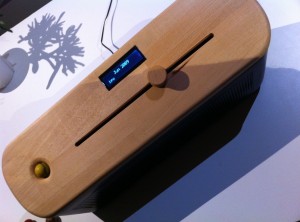Last week, I was invited to the Copenhagen Institute for Interaction Design to see student projects created during a four-week module on Tangible User Interfaces for home audio. I talked to one of the lead faculty, Vinay Venkatraman, and he said the theme was inspired by a recent trip to China coupled with his knowledge of Danish audio companies: while there was a lot of emphasis on the technical aspects of audio, companies weren’t giving much thought to the interaction design elements.
It was a fruitful area for the six student teams to explore. The projects mostly focused on two spaces: interfaces for home environments (especially the kitchen), and music discovery, especially within the users’ own collections. One piece for the kitchen was designed for the refrigerator door: it consisted of fist-sized ‘building blocks’ that connected together audio controls (volume, shuffle, source, skip). The students had set it up on an actual refrigerator door, which led to a moment of cross-cultural confusion. One of its creators said, “But this is a prototype–of course, the real thing would be smaller,” and I responded by saying, no, you’d want it to be nice and chunky so you could hit the controls with your wrist or arm if your hands were dirty from food prep. It took me a moment to realize that I was thinking of US-sized refrigerators (a little to a lot bigger than her demo door) and she was thinking of standard European refrigerators (a lot smaller!).
But my favourite piece, pictured above, was called Past.fm. Designed by Razan Sadeq, Hideaki Matsui, and Zubin Pastakia, it was rooted in how people associate particular songs with specific time periods, and vice versa. The little ball at the left is a token, which links to a particular Last.fm user. The slider then maps onto a date range, say April 2005 to June 2012. At each point, it plays your most-played song that month, and displays the title and artist in the display. The use of tokens means that you can listen to other users’ music history, or even things like ‘the most-played hip-hop of the last ten years.’ As someone with a carful of mix CDs with labels like “May 2008”, I really loved this idea of having a temporal jukebox.
As of this writing, they’re not up, but full details of all the student projects should be here shortly.
Thanks to Mayo Nissen for the intro, and Alie Rose for the invitation to visit CIID.








